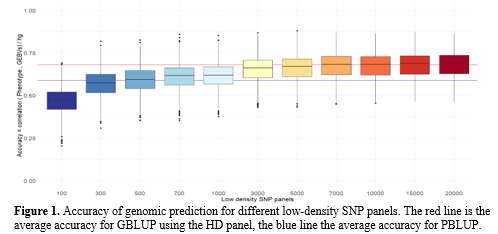GENOMIC SELECTION OF RESISTANCE TO Flavobacterium columnare IN RAINBOW TROUT USING LOW DENSITY SNP PANELS
Introduction
Columnaris disease (CD), caused by Flavobacterium columnare is an emerging disease affecting rainbow trout (Oncorhynchus mykiss) aquaculture worldwide. With no commercial vaccine available so far, selection to improve host resistance is of major importance for trout farmers. In aquaculture breeding, genomic selection has been increasingly used for traits that are difficult to measure on candidate fish (such as disease resistance traits). Previous studies suggested that rainbow trout resistance to CD could be improved by selective breeding, and that genomic selection was a useful approach to speed up this process (Silva et al., 2019). However, genomic selection can be prohibitively expensive as it requires genotyping of a large number of fish with high density genotyping arrays. The aim of this study was to assess the efficiency of genomic selection using low-density SNP panels for this disease resistance trait.
Material and methods
In May 2019, 105 rainbow trout families (from 33 dams and 48 sires) were produced from the Finnish national breeding programme maintained by Luke and their eggs were pooled. In June 2019, around 30,000 fry were separated into three fingerling tanks at the farm of Hanka-Taimen Oy (expected average of ~100 fish per family per tank). The fish were monitored daily for mortality, and when suspected signs of F. columnare were observed, the dying fish were sent to a veterinarian for a diagnosis. Once the presence of F. columnare was confirmed, the fish were treated with an approved treatment against CD to stop the outbreak. Simultaneously, about 510 fish with clear signs of CD per tank were randomly sampled among fish that died during the first 5 days of the disease outbreak. A piece of tail was sampled from those 1,531 fish for DNA extraction and genotyping. Thereafter, the fish rearing continued in the tanks, and in September-October 2019 tissue sample of 1,519 live randomly sampled fish were collected among the surviving fish. In total, 3,054 challenged fish and 81 parents were genotyped using the 57K SNP AxiomTM Trout Genotyping Array. After quality controls (QC), 27,907 SNPs were retained and used as the HD panel.
Resistance was analysed as a binary trait (0=alive; 1=dead) with the rearing tank as a fixed effect in the statistical model. The (genomic) estimated breeding values [(G)EBV] of fish were obtained using pedigree-based BLUP and genomic BLUP (GBLUP) computed with BLUPF90 software (Misztal et al., 2002). The efficiency of pedigree-based or genomic prediction was estimated using Monte-Carlo “leave-one-group-out” method by removing the known phenotype from 20% of the fish, and then using the remaining 80% fish and their information to predict the (G)EBVs of the 20% validation fish group. This was repeated 20 times. Accuracy of prediction was computed as the mean over the 20 replicates of the correlation between the (G)EBV and the true phenotype of fish in the validation group, divided by the square root of the genomic based heritability.
The impact of reducing the SNP density on genomic prediction was tested with eleven low to medium density in silico SNP panels. For each panel, SNPs were sampled from the 28K QC-filtered SNPs from the HD panel using the CVrepGPAcalc package (Tsairidou et al., 2020). The SNPs were randomly sampled within each chromosome without replacement, with the number of SNP sampled from a given chromosome being proportional to the physical length of the chromosome in the O. mykiss reference genome (Omyk_0.1, (Gao et al., 2018)). For each target density, 10 replicate panels were generated, which were allowed to overlap by chance. Genetic parameters and GEBVs were estimated as described above for each low-density panel.
Results and discussion
Pedigree based heritability was estimated to be 0.18 (± 0.038) on the observed scale, and genomic heritability was estimated to be 0.21 (± 0.029) on the observed scale. Pedigree-based prediction accuracy was 0.59 (± 0.080) and the use of genomic evaluation increased the prediction accuracy by 14% for the GBLUP (0.68 ± 0.076). Decreasing the number of SNPs used for the prediction tended to decrease the accuracy of genomic prediction (Figure 1). Accuracies obtained with 300 to 1000 SNPs were close to the accuracy of PBLUP. However, prediction accuracies obtained with SNP density panels from 3K and above were close to the accuracy obtained with the HD panel, suggesting that 3K may be a cost-effective SNP density at which to genotype in future studies and commercial practice.
Conclusion
In this study, we showed that using low density SNP panels (down to 5K or even 3K) would results in comparable accuracy than with the 28K HD SNPs panel. Reducing the SNP density is one way towards a more affordable genomic selection without losing efficiency. Approximately 3K SNP panels may provide a more affordable route to genomic prediction of breeding values with small compromise in accuracy.
Acknowledgment
This study is part of the AquaIMPACT project and was funded by the European Union’s Horizon 2020 research and innovation programme under grant agreement No 818367. The skilled staff of Savon Taimen Oy and Hanka-Taimen Oy are thanked for their expertise in data collection and fish rearing.
References
Gao, G., Nome, T., Pearse, D.E., Moen, T., Naish, K.A., Thorgaard, G.H., Lien, S., Palti, Y., 2018. A New Single Nucleotide Polymorphism Database for Rainbow Trout Generated Through Whole Genome Resequencing. Front. Genet. 9. https://doi.org/10.3389/fgene.2018.00147
Misztal, I., Tsuruta, S., Strabel, T., Auvray, B., Druet, T., Lee, D.H., 2002. BLUPF90 AND RELATED PROGRAMS (BGF90). Presented at the 7th World Congress on Genetics Applied to Livestock Production, Montpellier, France, p. 2.
Silva, R.M.O., Evenhuis, J.P., Vallejo, R.L., Gao, G., Martin, K.E., Leeds, T.D., Palti, Y., Lourenco, D.A.L., 2019. Whole-genome mapping of quantitative trait loci and accuracy of genomic predictions for resistance to columnaris disease in two rainbow trout breeding populations. Genet. Sel. Evol. GSE 51, 42. https://doi.org/10.1186/s12711-019-0484-4
Tsairidou, S., Hamilton, A., Robledo, D., Bron, J.E., Houston, R.D., 2020. Optimizing Low-Cost Genotyping and Imputation Strategies for Genomic Selection in Atlantic Salmon. G3 GenesGenomesGenetics 10, 581–590. https://doi.org/10.1534/g3.119.400800
